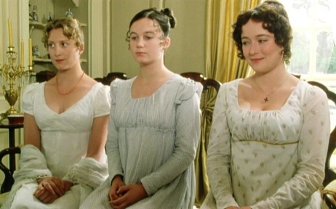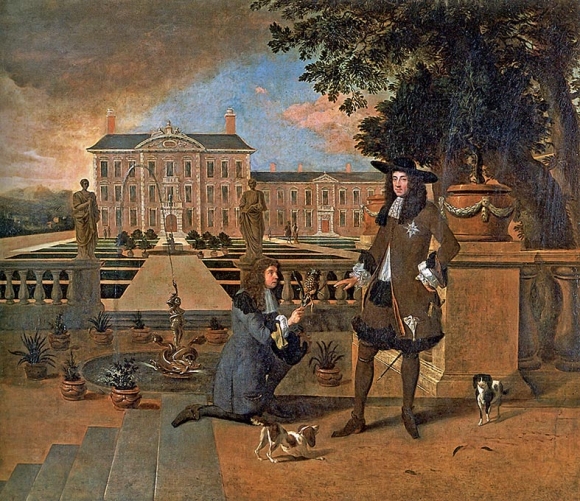The Effects of the French Revolution on Fashion
Sept 11, 2019 15:47:26 GMT -5
Ansgar Thegn, Windischer, and 1 more like this
Post by Aurelia on Sept 11, 2019 15:47:26 GMT -5
One of the most apparent markers of identity and station in society has been clothing and accouterments. Based on what fashions you wore, you could be identified as rich or poor; married or unmarried; young or old... During the French Revolution, the material of society dramatically changed, causing incredible, visible changes in the fashions from that era onward. For men, these new fashions would define the standard for men's apparel for the next centuries - for women, the change was only a temporary reprieve from the extreme voluminous skirts and under garments.
Prior to the French Revolution:
The center of fashion was firmly set in Paris prior to 1789; it took it's cues from the Court of Versailles where the mode of dress favored extravagant yardages of fabric and sumptuous trims. Patterns were allowing for extra volume in the skirt and sleeves, making the garments ungainly and obviously best suited to the more privileged classes who had more leisurely lifestyles.
(A fashion plate showing the extreme fullness of a dress skirt, accomplished with the help of stays, panniers and culs worn underneath.)

Men's apparel was highly ornate as well, often with gold embroidery and luxuriant trimmings and lace cuffs.
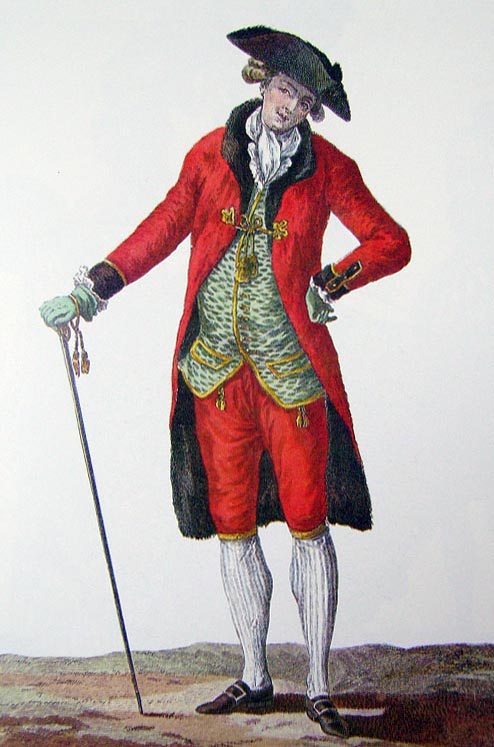

During the French Revolution, clothing became highly symbolic of one's political persuasions and social class... during The Terror, it was not only fashionable, but it was indeed safer to embrace a more naturalistic style that had up until then been associated with the lower, working classes. The dress of the Old Regime had favored silks, velvets, laces and ribbons - the colors for both men and women's dress were bright, highly eye-catching shades. Inspiration for fashion now shifted to English styles: he candy-colored fabrics fell out of style and were replaced with darker, more sensible fabrics, like cotton and embroidery was kept to a minimum. Les Incroyables and les merveilleuses were enamored of the clean tailoring and playful and dashing associated with their new-found l’anglomanie.
Here a side-by-side comparison shows the difference in decoration of both sets of clothes - in addition to the waistlines becoming drastically high in comparison to those worn before, all of the excessive lace and frippery were removed.
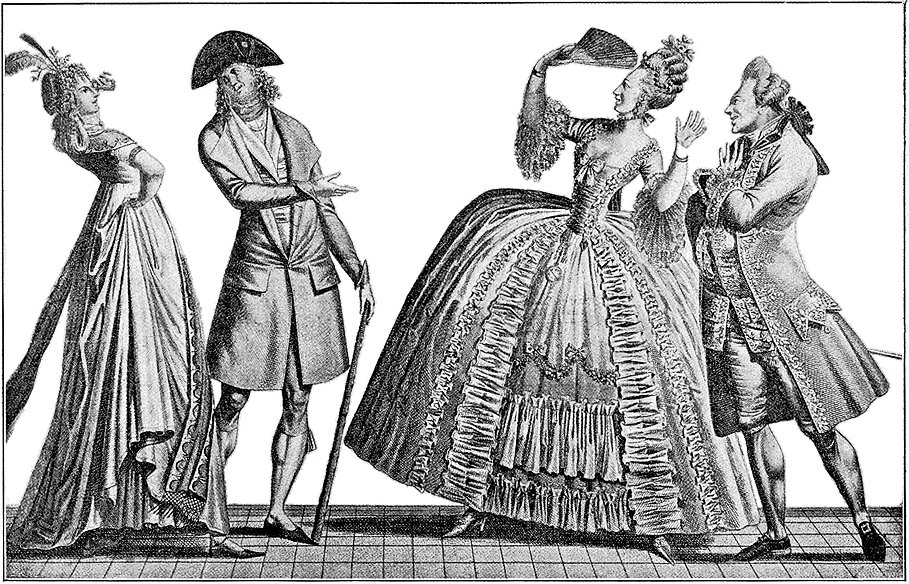
For men, breeches with white stockings slowly transitioned to trousers and pantaloons (pantaloons were essentially breeches that reached to just below the knee for wearing with tall boots). Trousers, which had been a working man's staple previously, were seen worn by the upper classes by 1807 - which only makes sense as society found equilibrium, there was a general shift towards wearing the styles of the common people.

A blue coat was a particularly patriotic choice in France... color became very important in conveying one's solidarity with the new republic.

The most drastic changes in fashion during the post-Revolution period was seen in women's dress. As a more naturalistic silhouette (one that mirrored the natural contours of the body) was en vouge, the restrictive stays were not necessarily needed under the high-waisted dresses. A fascination with Ancient Greece (and their style of diplomacy) worked it's way into the psyche of the public, and soon it was reflected in art and architecture as well as most notably in women's attire. The high-waisted Greek Chiton was perhaps influenced the styles of the Post-Revoultion / Regency eras most palpably... even down to the preferred coiffures.
The most notable aspect of this shift in dress for women was the fact that what had once been considered nothing more than an undergarment (robe en chemise) was now worn as a dress. The muslin fabrics were sheer, form-fitting ... and often had very little worn beneath them. The overall seductive quality to the look was completed by wetting the front of the dress, so that it clung to the body (causing them to look much like the Greek statues their fashions mimicked, where the cloth seemed to hug the figures). While many associate the era with the sort of subdued, respectable approach to sexuality and romance as played out in Jane Austen novels, the reality was that the garments of this era were radically freeing, highly sensual and a bit of a social revolution all on their own.
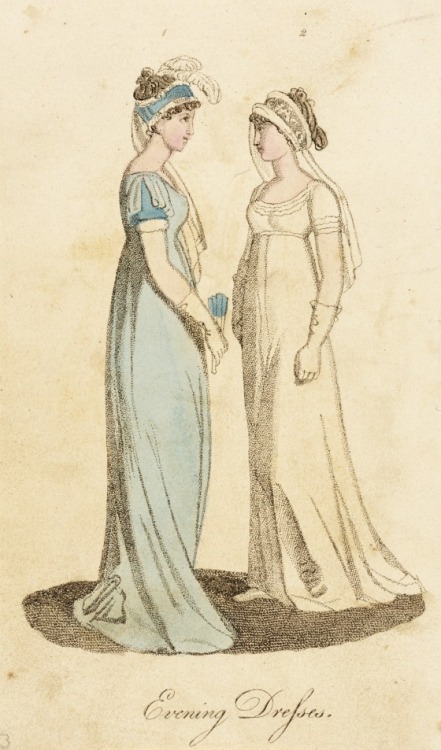


For men, the shift in mode of dress during the French Revolution made lasting changes on the silhouette of men's clothing - colors would remain sober, trousers would become the norm, and laces and finery would be left to women only.
Oddly, the changes in women's fashion were to be short lived. Very soon, there was a return to restrictive undergarments used to enhance the waist and show off the volume of skirts... in many ways the robe en chemise was a blip in the timeline of historical clothing...
Does anyone have any theories as to why there was this sort of regression to hoops skirts and mutton sleeves as seen during the Victorian era?
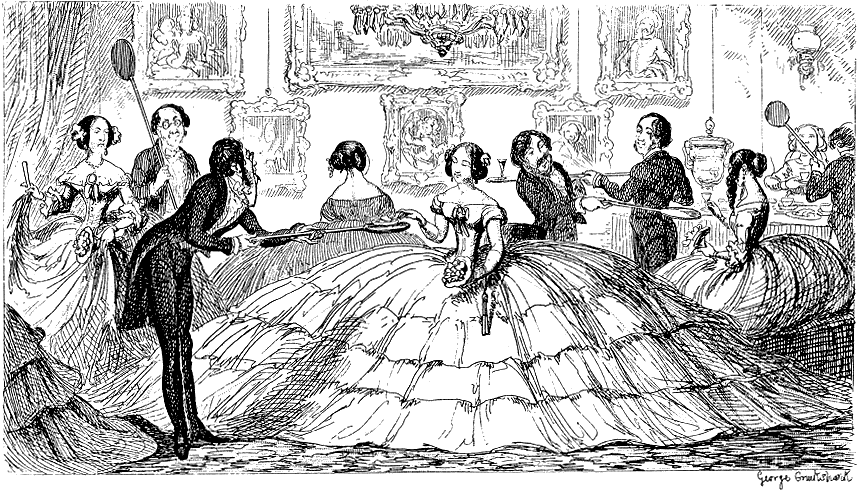
A cartoon by George Cruikshank 1850
Prior to the French Revolution:
The center of fashion was firmly set in Paris prior to 1789; it took it's cues from the Court of Versailles where the mode of dress favored extravagant yardages of fabric and sumptuous trims. Patterns were allowing for extra volume in the skirt and sleeves, making the garments ungainly and obviously best suited to the more privileged classes who had more leisurely lifestyles.
(A fashion plate showing the extreme fullness of a dress skirt, accomplished with the help of stays, panniers and culs worn underneath.)

Men's apparel was highly ornate as well, often with gold embroidery and luxuriant trimmings and lace cuffs.


During the French Revolution, clothing became highly symbolic of one's political persuasions and social class... during The Terror, it was not only fashionable, but it was indeed safer to embrace a more naturalistic style that had up until then been associated with the lower, working classes. The dress of the Old Regime had favored silks, velvets, laces and ribbons - the colors for both men and women's dress were bright, highly eye-catching shades. Inspiration for fashion now shifted to English styles: he candy-colored fabrics fell out of style and were replaced with darker, more sensible fabrics, like cotton and embroidery was kept to a minimum. Les Incroyables and les merveilleuses were enamored of the clean tailoring and playful and dashing associated with their new-found l’anglomanie.

Here a side-by-side comparison shows the difference in decoration of both sets of clothes - in addition to the waistlines becoming drastically high in comparison to those worn before, all of the excessive lace and frippery were removed.

For men, breeches with white stockings slowly transitioned to trousers and pantaloons (pantaloons were essentially breeches that reached to just below the knee for wearing with tall boots). Trousers, which had been a working man's staple previously, were seen worn by the upper classes by 1807 - which only makes sense as society found equilibrium, there was a general shift towards wearing the styles of the common people.

A blue coat was a particularly patriotic choice in France... color became very important in conveying one's solidarity with the new republic.

The most drastic changes in fashion during the post-Revolution period was seen in women's dress. As a more naturalistic silhouette (one that mirrored the natural contours of the body) was en vouge, the restrictive stays were not necessarily needed under the high-waisted dresses. A fascination with Ancient Greece (and their style of diplomacy) worked it's way into the psyche of the public, and soon it was reflected in art and architecture as well as most notably in women's attire. The high-waisted Greek Chiton was perhaps influenced the styles of the Post-Revoultion / Regency eras most palpably... even down to the preferred coiffures.
The most notable aspect of this shift in dress for women was the fact that what had once been considered nothing more than an undergarment (robe en chemise) was now worn as a dress. The muslin fabrics were sheer, form-fitting ... and often had very little worn beneath them. The overall seductive quality to the look was completed by wetting the front of the dress, so that it clung to the body (causing them to look much like the Greek statues their fashions mimicked, where the cloth seemed to hug the figures). While many associate the era with the sort of subdued, respectable approach to sexuality and romance as played out in Jane Austen novels, the reality was that the garments of this era were radically freeing, highly sensual and a bit of a social revolution all on their own.



For men, the shift in mode of dress during the French Revolution made lasting changes on the silhouette of men's clothing - colors would remain sober, trousers would become the norm, and laces and finery would be left to women only.
Oddly, the changes in women's fashion were to be short lived. Very soon, there was a return to restrictive undergarments used to enhance the waist and show off the volume of skirts... in many ways the robe en chemise was a blip in the timeline of historical clothing...
Does anyone have any theories as to why there was this sort of regression to hoops skirts and mutton sleeves as seen during the Victorian era?

A cartoon by George Cruikshank 1850






